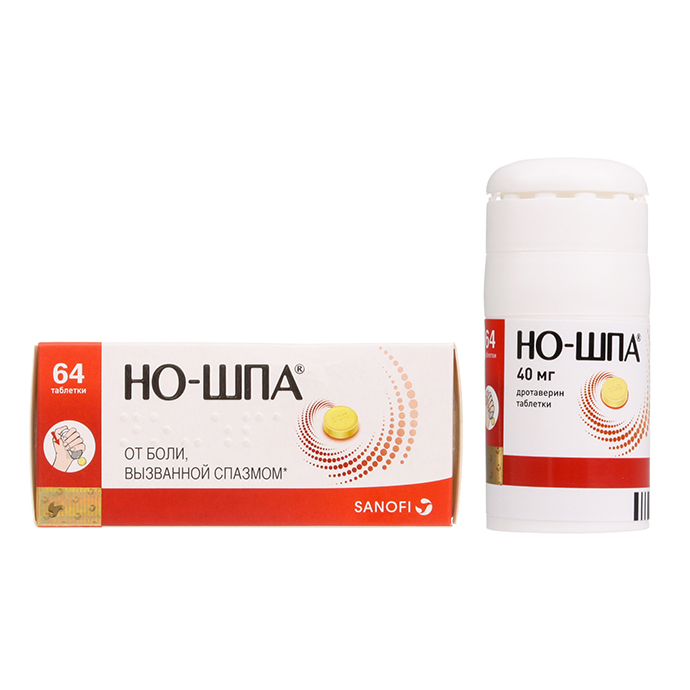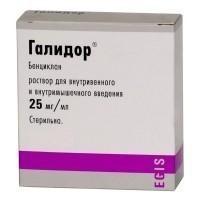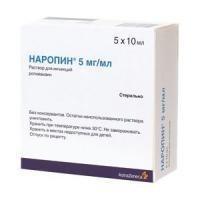Description
Pharmacological action
ATX code: A03A D02
Pharmacological properties:
Pharmacodynamics
Drotaverinum is a derivative of isoquinoline which exhibits a powerful antispasmodic effect on smooth muscle due to enzyme inhibition of phosphodiestephosphate. The enzyme phosphodiesterase is necessary for the hydrolysis of cyclic adenosine monophosphate (cAMP) to adenosine monophosphate (AMP). Inhibition of the phosphodiesterase enzyme leads to an increase in cAMP concentration which triggers the following cascade reaction: high cAMP concentrations activate cAMP-dependent phosphorylation of myosin light chain kinase phosphorylation (MLC). Phosphorylation of MLCK leads to a decrease in its affinity for the Ca2 + -calmodulin complex, as a result of which the inactivated form of MLCK supports muscle relaxation. cAMP also affects the cytosolic concentration of Ca2 + ion due to the stimulation of Ca2 + transport to extracellular space and sarcoplasmic reticulum. This effect of drotaverine through cAMP lowering the concentration of Ca2 + ion explains the antagonistic effect of drotaverinate with respect to Ca2 +.
In vitro, drotaverine inhibits PDE IV isoenzyme without inhibiting PDE III and PDEV isoenzymes. Therefore, the effectiveness of drotaverine depends on the concentration of PDE IV in tissues, the content of which varies in different tissues. PDE IV is most important for suppressing contractile activity of smooth muscles, therefore, selective inhibition of PDE IV may be useful for the treatment of hyperkinetic dyskinesias and various diseases accompanied by a spastic condition of the gastrointestinal tract.
The hydrolysis of cAMP in the myocardium and vascular smooth muscle occurs mainly with the help of the PDE III isoenzyme, which explains the fact that with high antispasmodic activity, drotaverine has no serious side effects from the heart and blood vessels and pronounced effects on the cardiovascular system .
Drotaverinum is effective for spasms of smooth muscles of both neurogenic and muscular origin. Regardless of the type of autonomic innervation, drotaverin relaxes the smooth muscles of the gastrointestinal tract, biliary tract, and genitourinary system.
Pharmacokinetics
Absorption:
After oral administration, drotaverine is rapidly and completely absorbed. After a presystemic metabolism, 65% of the accepted dose of drotaverine enters the systemic circulation. The maximum plasma concentration (Cmax) is reached after 45-60 minutes.
Distribution of
In vitro drotaverin has a high plasma deal (95-98%), especially with albumin and – globumins.
Drotaverine is evenly distributed throughout the tissues, penetrates smooth muscle cells. Does not cross the blood-brain barrier. Drotaverin and / or its metabolites may slightly penetrate the placental barrier.
Metabolism
In humans, drotaverine is almost completely metabolized in the liver by O-deethylation. Its metabolites are rapidly conjugated to glucuronic acid. The main metabolite is 4′-desethyldrotaverine, in addition to which 6-desethyldrotaverin and 4′-desethyldrothaveraldine were identified.
Derivation of
In humans, a two-chamber mathematical model was used to evaluate the pharmacokinetics of drotaverine. The final half-life of plasma radioactivity was 16 hours.
Within 72 hours, drotaverine is almost completely eliminated from the body. More than 50% of drotaverin is excreted by the kidneys and about 30% through the gastrointestinal tract (excretion into bile). Drotaverin is mainly excreted in the form of metabolites, unchanged drotaverin in urine is not detected.
Indications
Smooth muscle spasms associated with diseases of the biliary tract: cholecystolithiasis, cholangiolithiasis, cholecystitis, pericholecystitis, cholangitis, papillitis.
spasms of smooth muscles of the urinary tract: nephrolithiasis, urethrolithiasis, pyelitis, cystitis, tenesmus of the bladder.
As adjuvant therapy:
For spasms of smooth muscles of the gastrointestinal tract: gastric and duodenal ulcer, gastritis, cardia and pyloric spasms, enteritis, colitis, spastic, colitis with constipation and irritable bowel syndrome with flatulence after the exclusion of diseases, acute abdominal syndrome (appendicitis, peritonitis, ulcer perforation, acute pancreatitis, etc.).
For tension headaches.
With dysmenorrhea.
Contraindications
Hypersensitivity to the active substance or to any of the excipients of the
preparation Severe hepatic or renal failure
Severe heart failure (low cardiac output syndrome)
Children under 6 years of age breast-feeding (no clinical data).
Rare hereditary galactose intolerance, lactase deficiency and glucose-galactose malabsorption syndrome (due to the presence of lactose in the preparation).
Precautions:
– For arterial hypotension.
– In children (lack of clinical experience).
– In pregnant women (see section “Pregnancy and lactation”).
Use in pregnancy and lactation
As animal reproduction experiments and retrospective studies of clinical data have shown, the use of drotaverine during pregnancy does not lead to either teratogenic or embryotoxic effects. However, the use of the drug is recommended only after careful weighing of the ratio of benefit and risk.
In the absence of the necessary clinical data during lactation is not recommended.
Special instructions
No-shpa ® 40 mg tablets contain 52 mg of lactose. This can cause gastrointestinal complaints in people with lactose intolerance. This form is unacceptable for patients suffering from lactose deficiency, galactosemia or a syndrome of impaired glucose / galactose absorption (see section “Contraindications”).
Influence on the ability to drive a car and other mechanisms
When taken orally in therapeutic doses, drotaverin does not affect the ability to drive a car and perform work requiring increased attention. If any side effects occur, the issue of driving a transport and working with mechanisms requires individual consideration. In case of dizziness after taking the drug, you should avoid engaging in potentially hazardous activities, such as driving and working with machinery.
Composition of
Active ingredient: drotaverine hydrochloride – 40 mg
excipients: magnesium stearate – 3 mg, talcum powder – 4 mg, povidone – 6 mg mg srdl, srd lactose monohydrate – 52 mg.
Dosage and administration of
Adults
Typically, the average daily dose in adults is 120-240 mg (daily dose is divided into 2-3 doses). The maximum single dose is 80 mg. The maximum daily dose is 240 mg.
Children
clinical studies using drotaverine in children have not been conducted.
In case of prescribing drotaverine to children:
– for children from 6 to 12 years old, the maximum daily dose is 80 mg, divided into 2 doses.
– for children over 12 years of age, the maximum daily dose is 160 mg, divided into 2-4 doses. Duration of treatment without consulting a doctor
When taking the drug without consulting a doctor, the recommended duration of taking the drug is usually 1-2 days. If during this period the pain does not decrease, the patient should consult a doctor to clarify the diagnosis and, if necessary, change the therapy. In cases where drotaverine is used as adjuvant therapy, the duration of treatment without consulting a doctor may be longer (2-3 days).
Method for assessing the effectiveness of
If a patient can easily diagnose the symptoms of his disease on his own, since they are well known to him, the effectiveness of the treatment, namely the disappearance of pain, is also easily evaluated by the patient. If within a few hours after taking the maximum single dose there is a moderate decrease in pain or, the absence of a decrease in pain, or if the pain does not significantly decrease after taking the maximum daily dose, it is recommended to consult a doctor.
Side effects
The following are the adverse reactions observed in clinical trials, divided into systems, organs with an indication of their frequency of occurrence in accordance with the following gradations: very frequent (? 10%), frequent (? 1%, <10) infrequent (? 0.1%, <1%) rare (? 0.01%, <0.1%) and very rare, including single messages (<0.01%), unknown frequency (according to available data frequency cannot be determined). From the cardiovascular system Rare – increased heart rate, lowering blood pressure. From the nervous system Rare – headache, dizziness, insomnia. From the gastrointestinal tract Rare – nausea, constipation. On the part of the immune system Rare – allergic reactions (angioedema, urticaria, rash, itching) (see section “Contraindications”). Drug Interactions With levodopa Phosphodiesterase inhibitors like papaverine reduce the antiparkinsonian effect of levodopa. With the appointment of drotaverine simultaneously with levodopa, increased rigidity and tremor are possible. With other antispasmodic drugs, including m-anticholinergic drugs. Mutual enhancement of antispasmodic action. Drugs that significantly bind to plasma proteins (more than 80%) Drotaverin significantly binds to plasma proteins, predominantly albumin, ? and? -globulins (see the section “Pharmacokinetics”). There is no data on the interaction of drotaverine. with drugs that significantly bind to plasma proteins, however, there is a hypothetical possibility of their interaction with drotaverine at the level of protein binding (displacing one of the drugs with another due to protein and increasing the concentration of the free fraction in the blood of a drug with a less strong protein binding), which is hypothetically may increase the risk of pharmacodynamic and / or toxic side effects of this drug. Overdose There are no data on overdose of the drug. In case of overdose, patients should be under medical supervision and, if necessary, they should undergo symptomatic and aimed at maintaining the basic functions of the body treatment, including artificial inducing vomiting or gastric lavage. Storage conditions For tablets in blisters Aluminum / Aluminum: store at a temperature not exceeding 30 ° C. For tablets in PVC / Aluminum Blisters: Store at a temperature not exceeding 25 ° C. For tablets in vials: store in a dark place at a temperature of 15 ° C to 25 ° C. Keep out of the reach of children. Expiration For tablets in blisters Aluminum / Aluminum: 5 years. For tablets in PVC / Aluminum blisters: 3 years. For tablets in vials: 5 years. Deystvuyuschee substances Drotaverine Pharmacy over-the-counter conditions Dosage form tablets Appointment adult u doctor, Detyam over 6 years Indications From gallstone disease, From cholecystitis, From gastroduodenitis, From colitis, From gastrointestinal tract, Cystitis, Cystitis, Cystitis, Cystitis Possible product names No-shpa tablets 40 mg 64 pcs.



